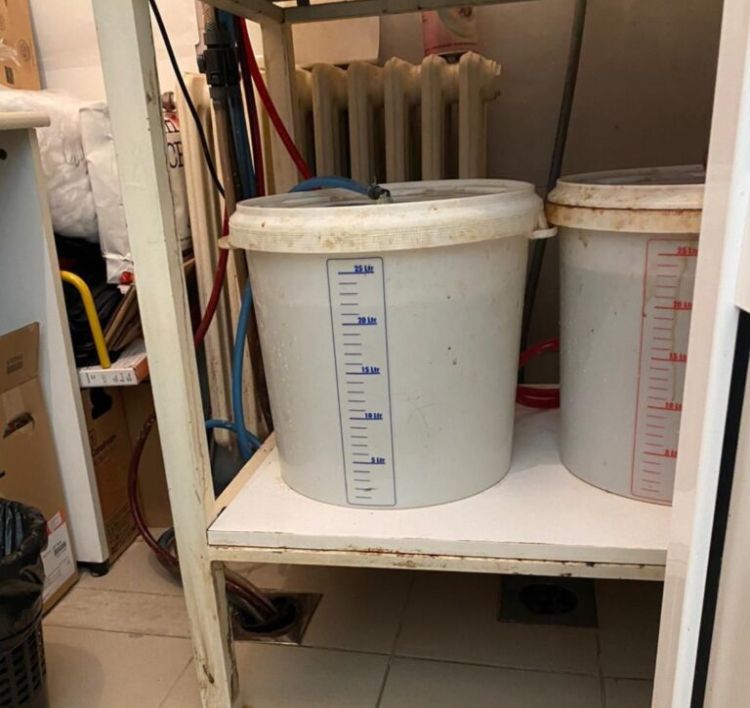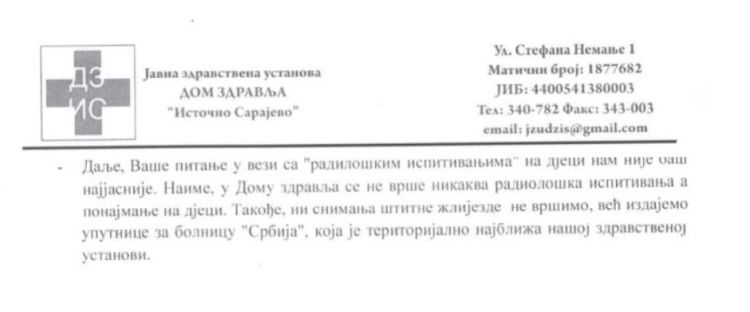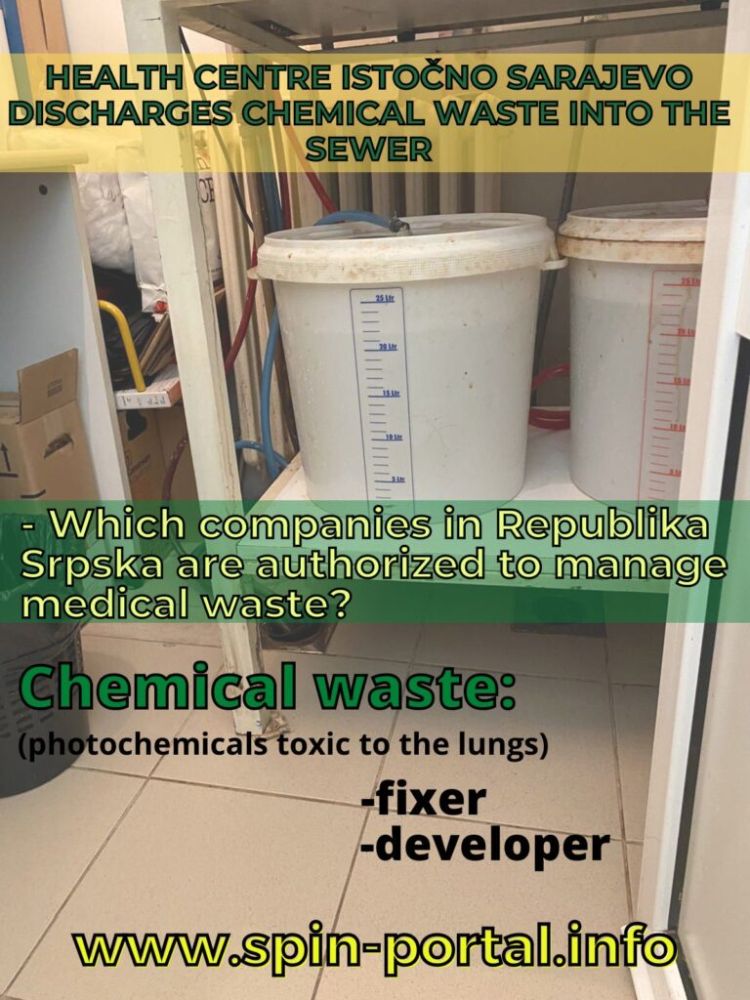
Health institutions in Republika Srpska, in addition to millions of losses, the departure of professional staff, and the lack of adequate medical equipment, which directly affects the health of the residents, also have problems with inadequate disposal of medical waste that requires special treatment. Additional financial resources are needed for this, and the consequences of unprofessional management of this waste and its harm to citizens’ health and nature are incalculable.
Chemical waste in sewage
Medical waste generated in a healthcare facility is stored at a specific location within the facility, before being disposed of, transported, or transferred to another recipient. Medical waste also includes chemical waste, and Dom zdravlja (Health centre) Istočno Sarajevo discharges this waste directly into the sewage system, which, according to our sources, flows into the Dobrinja river. It is an extremely toxic waste that is created after the development of radiological films.
“It is known that two components are used to develop radiological film, i.e. developer and fixer, and they actually represent photochemicals. The developer is an organic compound used to develop X-ray film, the purpose of which is to deposit elemental silver from the silver bromide photoemulsion (film). On the other hand, the fixer is a chemical compound consisting of 20-25% sodium thiosulfate solution. It is important to point out that sodium thiosulfate is extremely toxic to the lungs. Chemical waste, i.e. fixer and developer, also contain heavy metals and silver”, an expert in this field told SPIN Info.

If we take into account the period of the coronavirus pandemic when a huge number of patients had to have their lungs scanned, we can only guess in what quantity these photochemicals were released into the sewers.
“The head of a health care institution, in accordance with his powers, has the obligation to take measures to protect the health of health care workers, workers transporting medical waste, and to protect the population from health risks as a result of the creation of medical waste in the health care facility. The manager is obliged to ensure that medical waste is treated in a safe and environmentally safe manner”, it is stated in the Ordinance on the management of medical waste published in the Official Gazette of Republika Srpska (number 53/02).
The management of the Health Center Istočno Sarajevo, led by the director Šešelj Dejan, in their response to our portal on the management of this waste, stated that this institution has a concluded contract on the disposal of medical waste with the company “Reciklon” d.o.o. from Sarajevo, specialized in the disposal of hazardous and non-hazardous waste, ecology and infectious waste, without specifying how chemical waste is specifically treated.
Also, contracts are drawn up according to different items, which do not have to cover the entire waste produced in an institution, which is very suitable for manipulating and violating the law. The question is how much money, at the expense of the health of citizens and endangering the environment, the health care institutions, which are grunting in debt, save in this way.
Chemical waste should be packed in appropriate packaging and temporarily stored, after which it is taken over by authorized companies.
We also asked the Ministry of Spatial Planning, Construction and Ecology of Republika Srpska which companies are authorised to manage medical waste, as well as other categories of hazardous waste in Republika Srpska, however, we did not receive an answer.
The ecological association “Eko Akcija” believes that the problem of hospital waste is widespread.
“Health care facilities produce an abundance of infectious waste that must be adequately disposed of. Also, the newer X-ray devices are now predominantly digital, and there is no film or chemicals”, the association “Eko Acija” told our portal.
Leakage of patients’ personal data?
In addition to the inadequate treatment of chemical waste, the managers of the Health Center have numerous other problems. Namely, a mobile X-ray device was recently donated to the Health Center Istočno Sarajevo, which in practice is most often used in intensive care units or those where patients who cannot move independently are accommodated, which is the specificity of hospital patients, not those in health centres.
The device is extremely modernized, has Wi-Fi, and has the ability to burn CDs. However, in defiance of the regulations, in the Radiological Outpatient Clinic of the Health Center Istočno Sarajevo, they connected a static X-ray with a mobile device via a Wi-Fi connection, that is, they modified this device to their own measure and thus probably lost the warranty on it. This is not the intended use of this device, which is configured to record and burn a CD on its own, without sending the data on. Simply put, a static x-ray must have a digitizer to which it is connected by cable, not a Wi-Fi connection. Apparently, this process also jeopardizes the protection of data, because they are sent via Wi-Fi, which opens up the possibility of “leakage” of personal and medical data.
The Health Center tells us that the mobile device is fully usable, especially when it comes to immobile patients, but they still did not look at whether its primary purpose is in hospitals, and not health centres.
Improving the health of the youngest patients
During the radiological examination and standard radiological diagnosis, experts working in the zone with ionizing radiation (X-ray technician/radiological engineer) must provide the patient with protection for the gonads and thyroid gland, which according to patients, the Health Center Istočno Sarajevo does not have. This is especially dangerous for the youngest patients, and this type of protection is taken for granted in most countries.
The Health Center announced that our question was not formulated correctly, because instead of the term radiological diagnosis, we used the term radiological examination, and they do not perform any radiological examinations. In this way, they skillfully avoided the answer about possibly not having the mentioned protection and they also emphasized that they do not perform imaging of the thyroid gland. However, experts say that during imaging of the child’s lungs, it is necessary to put on a lead apron for the gonads (genitals) so that the beam of ionizing radiation does not spread to unnecessary parts of the body. The problem of paediatricians in the health centre, which the director himself spoke about at the session of the Istočna Ilidža municipal assembly recently, is a special problem, as is the shortage of doctors from the gynaecology department.

“If you make an appointment with a gynaecologist today, your turn will only be in four months”, said director Šešelj from the assembly speaker.
The systemic problems of health institutions, which have not escaped the Health Center in Istočno Sarajevo, are conducive to the increase of corruption in health care, which is one of the most pressing problems in Bosnia and Herzegovina.


